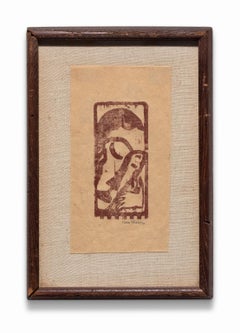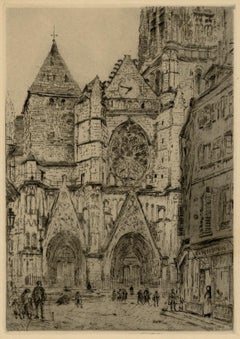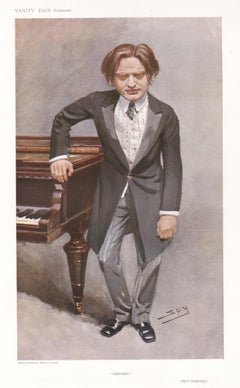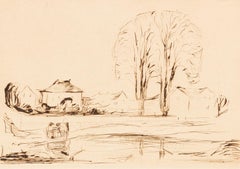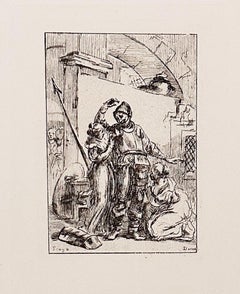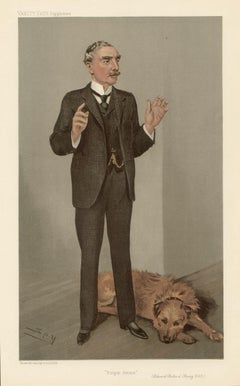Early 20th Century Figurative Prints
to
782
2,414
541
242
77
80
Overall Width
to
Overall Height
to
1,401
265
244
142
125
36
25
11
3
2
1
1
170
102
57
56
43
3,634
7,760
25,018
6,686
285
584
1,430
1,207
1,244
2,187
2,978
5,152
2,943
1,450
3,102
2,360
973
19
2,711
1,469
1,304
1,063
806
795
550
272
202
177
173
162
152
143
125
124
117
82
71
59
1,150
1,100
597
448
365
338
1,253
1,532
1,303
Period: Early 20th Century
Max Weber Woodcut Print from "Primitives" Poetry Book Signed
By Max Weber
Located in Detroit, MI
ONE WEEK ONLY SALE
This woodcut print is an expressionist print on one of the poems from Max Weber's poetry collection "Primitives: Poems and Woodcuts". This work is signed in penci...
Category
Expressionist Early 20th Century Figurative Prints
Materials
Woodcut
Meaux Cathedral II
By John Marin
Located in Middletown, NY
Paris: Gazette de Beaux Arts, 1907. Etching with aquatint on cream wove paper, 8 7/8 x 11 1/2 inches (225 x 292 mm), narrow lefthand margin, with a full margin with a deckle edge on ...
Category
English School Early 20th Century Figurative Prints
Materials
Handmade Paper, Etching, Aquatint
'Impromptu', Mark Hambourg, Vanity Fair musician caricature portrait, 1908
Located in Melbourne, Victoria
'Impromptu'
Chromolithograph. 1908.
Vanity Fair portrait of Mark Hambourg (1879-1960) who was a distinguished Russian-British concert pianist, among the most famous of his age.
...
Category
Victorian Early 20th Century Figurative Prints
Materials
Lithograph
Fra Åsgårdstrand (Schiefler 260; Woll 289), Edvard Munch
By Edvard Munch
Located in Southampton, NY
Drypoint on gewöhnlichem aber holzfreiem vélin paper. Unsigned and unnumbered, as issued. Good Condition. Notes: From the album, Verzeichnis Des graphischen Werks Edvard Munchs Bis 1...
Category
Expressionist Early 20th Century Figurative Prints
Materials
Drypoint
$15,996 Sale Price
20% Off
Don Quixote
Located in Middletown, NY
Etching on a large sheet of light cream wove paper, Baron Dominique Vivant Denon (after Jean-Honoré Fragonard); Paris: c 1900; 4 3/4 x 3 1/2 inc...
Category
French School Early 20th Century Figurative Prints
Materials
Handmade Paper, Etching
'Finger Prints', Sir Edward Richard Henry, Vanity Fair caricature portrait, 1895
Located in Melbourne, Victoria
'Finger Prints'
Chromolithograph. 1905.
Vanity Fair portrait of Sir Edward Richard Henry, 1st Baronet GCVO KCB CSI KPM (1850-1931) who was the Commissioner of Police of the Metropo...
Category
Victorian Early 20th Century Figurative Prints
Materials
Lithograph
" Le Miroir Magique " . Musée FABRE .
Located in CANNES, FR
Jean HUGO ( 1894 - 1984 )
" Le miroir Magique " . PARIS .Jeanne Buchet .1927.
Musée FABRE . Montpellier .
portefeuille de 20 lithographies coloriées sur pochoir par
Jean saudé d'apré...
Category
Surrealist Early 20th Century Figurative Prints
Materials
Archival Paper
Henri Matisse, Crayon, from Drawings by Henri Matisse, 1925 (after)
Located in Southampton, NY
This exquisite lithograph after Henri Matisse (1869–1954), titled Crayon (Crayon), from the album Dessins de Henri-Matisse (Drawings by Henri Matisse), originates from the 1925 editi...
Category
Modern Early 20th Century Figurative Prints
Materials
Lithograph
$956 Sale Price
20% Off
Caryatid of the Erechtheum, British Museum Greek Classical photogravure
Located in Melbourne, Victoria
'Caryatid of the Erechtheum'
Photogravure from a collection of photogravures depicting Greek and Roman marbles and bronzes in the British museum. Plate number above top right corner...
Category
Other Art Style Early 20th Century Figurative Prints
Materials
Photogravure
Ottokar Mascha Folio: plate 11 "5th Secession Exhibition Poster" by Kolo Moser
Located in Palm Beach, FL
after KOLOMAN MOSER (1868-1918) 5TH SECESSION EXHIBITION POSTER, 1899, (In Mascha, no. 11) A pivotal figure in early-20th century Austrian ...
Category
Vienna Secession Early 20th Century Figurative Prints
Materials
Lithograph
Psyche on a Rock - Etching by Max Klinger - 1909
By Max Klinger
Located in Roma, IT
Etching and aquatint realized in 1909.
Belongs to the series "Amor und Psyche. Opus V".
Very good condition.
Category
Symbolist Early 20th Century Figurative Prints
Materials
Etching
Ludgate Hill
Located in Middletown, NY
Etching with drypoint and aquatint on light cream wove paper, 5 1/2 x 5 inches (140 x 122 mm), full margins. Signed in pencil in the lower margin. One of a total of 400 signed impres...
Category
Modern Early 20th Century Figurative Prints
Materials
Drypoint, Etching, Aquatint
Akt mit Fächer
By Marc Chagall
Located in New York, NY
A superb, richly-inked impression of an early etching and drypoint. With burr throughout and crisp plate edges. First state (of 2). Edition of 100. Signed in pencil by Chagall. Print...
Category
Expressionist Early 20th Century Figurative Prints
Materials
Drypoint, Etching
A Fierce Bull
By James McBey
Located in Storrs, CT
A Fierce Bull. 1911. Drypoint. Hardie 108. 5 3/8 x 8 (sheet 8 5/16 x 11 7/8). Edition 8. An exceptional impression with rich drypoint burr printed on antique laid paper. A proof of t...
Category
Modern Early 20th Century Figurative Prints
Materials
Drypoint, Etching
$1,500 Sale Price
40% Off
Don Quixote Reading
Located in Middletown, NY
Etching on a large sheet of light cream wove paper, Baron Dominique Vivant Denon (after Jean-Honoré Fragonard); Paris: c 1900; 4 3/4 x 3 1/2 inc...
Category
French School Early 20th Century Figurative Prints
Materials
Handmade Paper, Etching
The Portland Vase, British Museum Roman antiquity photogravure
Located in Melbourne, Victoria
'The Portland Vase'
Photogravure after Donald Macbeth (1865-1943).
Donald Macbeth was a commercial photographer who seems to have held a quasi-official position at the British Muse...
Category
Other Art Style Early 20th Century Figurative Prints
Materials
Photogravure
Die Bettler (The Beggars)
By Max Beckmann
Located in Fairlawn, OH
Die Bettler (The Beggars)
Lithograph, 1922
Signed in pencil lower right (see photo)
From: Berliner Reise Series, Plate 7
Printed on wove paper
Edition: 100...
Category
Expressionist Early 20th Century Figurative Prints
Materials
Lithograph
Red Cross Christmas Roll Call original World War 1 vintage poster
By Edwin Howland Blashfield
Located in Spokane, WA
Original poster: Red Cross Christmas Roll Call. “Where Columbia sets her name let every one of you follow her” Linen-backed in very good condition, ready to frame. Artist: Edwin Howland Blashfield.
The Red Cross stands on the left helping hold the banner that reads Where Columbia sets her name let every one of you follow her.
December 16th to 23d. World War 1...
Category
Art Nouveau Early 20th Century Figurative Prints
Materials
Lithograph
Henri Matisse, Crayon, from Drawings by Henri Matisse, 1925 (after)
Located in Southampton, NY
This exquisite lithograph after Henri Matisse (1869–1954), titled Crayon (Crayon), from the album Dessins de Henri-Matisse (Drawings by Henri Matisse), originates from the 1925 edition published by Editions des Quatre Chemins, Paris, rendered by Daniel Jacomet, Paris, and printed by Atelier Daniel Jacomet et Cie, Paris, December 15, 1925. The work exemplifies Matisses mastery of pure line and the expressive economy of form that defined his graphic art of the 1920s, transforming simplicity into lyrical harmony.
Executed as a lithograph on velin Lafuma Navarre paper, this work measures 8 x 10 inches (20.32 x 25.4 cm). Unsigned and unnumbered, as issued. The edition exemplifies the refined craftsmanship of the Daniel Jacomet et Cie workshops, Paris.
Artwork Details:
Artist: After Henri Matisse (1869–1954)
Title: Crayon (Crayon), from the album Dessins de Henri-Matisse (Drawings by Henri Matisse)
Medium: Lithograph on velin Lafuma Navarre paper
Dimensions: 8 x 10 inches (20.32 x 25.4 cm)
Inscription: Unsigned and unnumbered, as issued
Date: 1925
Publisher: Editions des Quatre Chemins, Paris
Printer: Atelier Daniel Jacomet et Cie, Paris
Catalogue Raisonne Reference: Duthuit, Claude. Henri Matisse: Catalogue raisonne des ouvrages illustres. Editions Claude Duthuit, Paris, 1988, illustration 3.
Condition: Well preserved, consistent with age and medium
Provenance: From the album Dessins de Henri-Matisse (Drawings by Henri Matisse), published by Editions des Quatre Chemins, Paris; rendered by Daniel Jacomet, Paris; printed by Atelier Daniel Jacomet et Cie, Paris, December 15, 1925
Notes:
Excerpted from the album (translated from French), This album was printed in C examples on velin d'Arches with an original example by Henri-Matisse, numbered from I to C, and M examples on velin Lafuma. Printing was completed on December Fifteenth, One Thousand, Nine Hundred and Twenty-Five by F. Dutal et Cie, in Paris; the boards having been executed by the Daniel Jacomet et Cie workshops in Paris.
About the Publication:
Dessins de Henri-Matisse (Drawings by Henri Matisse), published by Editions des Quatre Chemins, Paris, in 1925, is a landmark early graphic portfolio that captures the artist’s mastery of contour and proportion through a series of delicately rendered lithographs. Realized under the direction of the Daniel Jacomet et Cie workshops—renowned for their exceptional skill in fine art printmaking—the album showcases Matisse’s fascination with the purity of line and the human form. Issued in a limited printing of examples on both velin d’Arches and velin Lafuma papers, it reflects the refined aesthetics and technical excellence that characterized the interwar Parisian print ateliers. The publication represents a pivotal stage in Matisse’s evolution as a draughtsman, bridging the intimate immediacy of his drawings with the permanence of fine print.
About the Artist:
Henri Matisse (1869–1954) was a French painter, sculptor, draughtsman, and printmaker whose revolutionary vision redefined modern art through his daring use of color, line, and form. Celebrated as one of the greatest artists of the 20th century, Matisse led the Fauvist movement and devoted his life to the pursuit of balance, beauty, and emotional expression in visual art. His early works burst with vibrant hues and liberated brushwork, while his later “cut-out” compositions achieved a poetic simplicity that transformed the relationship between color and space. Deeply influenced by the work of Paul Cezanne, Vincent van Gogh, and Georges Seurat, as well as by the rhythmic patterns of Islamic art, Byzantine mosaics, and Japanese prints, Matisse forged a new visual language that celebrated joy, movement, and serenity. He was part of an extraordinary generation of artists who shaped the evolution of modernism, maintaining lifelong dialogue and friendly rivalry with contemporaries such as Pablo Picasso, Georges Braque, Marc Chagall, Andre Derain, Albert Marquet, and Raoul Dufy—peers who, like him, sought to expand the expressive potential of color and composition. Matisses influence extended across generations, inspiring modern and contemporary masters including Alexander Calder, Alberto Giacometti, Salvador Dali, Joan Miro, Wassily Kandinsky, Marcel Duchamp, and Man Ray, each of whom drew upon his fearless experimentation and refined visual harmony. His paintings, sculptures, and works on paper are held in the most prestigious museums in the world, including the Museum of Modern Art, the Centre Pompidou, the Tate, and the Hermitage Museum, where his art continues to symbolize the essence of creativity and human emotion. The highest price ever paid for a Henri Matisse artwork is approximately 80.8 million USD, achieved in 2018 at Christies New York for Odalisque couchee aux magnolias (1923).
Henri Matisse Crayon...
Category
Modern Early 20th Century Figurative Prints
Materials
Lithograph
$956 Sale Price
20% Off
Henri Matisse, Crayon, from Drawings by Henri Matisse, 1925 (after)
Located in Southampton, NY
This exquisite lithograph after Henri Matisse (1869–1954), titled Crayon (Crayon), from the album Dessins de Henri-Matisse (Drawings by Henri Matisse), originates from the 1925 editi...
Category
Modern Early 20th Century Figurative Prints
Materials
Lithograph
$956 Sale Price
20% Off
The Discobolus, British Museum Roman antiquity Classical sculpture photogravure
Located in Melbourne, Victoria
'The Discobolus'
Photogravure after Donald Macbeth. Donald Macbeth was a commercial photographer who seems to have held a quasi-official position at the British Museum, where he reg...
Category
Other Art Style Early 20th Century Figurative Prints
Materials
Photogravure
Seated Nude (version 1) from the portfolio Maillol: Sculpture and Lithography)
Located in New York, NY
Aristide Maillol
Seated Nude (version 1) from the portfolio Aristide Maillol: Sculpture and Lithography, 1925
Lithograph on watermarked paper
12 1/2 × 19 1/2 inches
Edition AP
Hand-s...
Category
Realist Early 20th Century Figurative Prints
Materials
Lithograph
The Hug - Lithograph by George Grosz - 1923
By George Grosz
Located in Roma, IT
The hug from Ecce Homo is an original offset and lithograph print, realized by George Grosz.
The artwork is the plate n. 83 from the porfolio Ecce Homo published between 1922/1923,e...
Category
Modern Early 20th Century Figurative Prints
Materials
Lithograph
$309 Sale Price
35% Off
Coleth : The Lovers of Venice Carnival - Original Art Deco pochoir
Located in Paris, IDF
Coleth
The Lovers of Venice Carnival
Original gouache and ink drawing (c. 1925)
Signed bottom right
On drawing paper 23 x 20 cm (c. 9 x 8 in) at view...
Category
Art Nouveau Early 20th Century Figurative Prints
Materials
Gouache, Stencil
THE WAGON SHOP
Located in Santa Monica, CA
GUSTAVE BAUMANN (1881 – 1971)
THE WAGON SHOP, 1910 (Chamberlain 24)
Color woodcut signed in pencil. Unnumbed from an edition 100 as published in the Hills o’ Brown...
Category
Modern Early 20th Century Figurative Prints
Materials
Woodcut
$1,800 Sale Price
20% Off
"Opium" Lithograph Poster by Theo Matejko
By Theo Matejko
Located in Palm Beach, FL
Frame is handmade by artist Gail Potocki.
WEAG-Matejko, Printer, Vienna
"In 1919, artist Theo Matejko created this lithograph for Robert Reinert's silent film Opium (starring Conra...
Category
Expressionist Early 20th Century Figurative Prints
Materials
Lithograph
Le Gladiateur - Lithograph by Giorgio de Chirico - 1929
Located in Roma, IT
Lithograph realized by De Chirico in 1929, and belonging to the famous suite "Metamorphosis".
Hand signed and numbered 57/100.
Ref: A. Ciranna, Giorgio de Chirico. Catalogo delle o...
Category
Modern Early 20th Century Figurative Prints
Materials
Lithograph
Peste Dessous Peste Dessus Peste Partout!-Original Etching by James Ensor-1900s
By James Ensor
Located in Roma, IT
Etching on zinc plate, realized in 1904 on japan paper. It is signed in plate in small letters at the bottom right.
On the lower right margin, it is signed also in pencil. Not dated...
Category
Modern Early 20th Century Figurative Prints
Materials
Etching
The Lovely Discussion - Woodcut by Mathilde Hérouard - 1920s
Located in Roma, IT
Woodcut print realized by Mathilde Hérouard in the 1920s.
Mounted on paper.
Signed in the plate.
Very good condition.
Category
Modern Early 20th Century Figurative Prints
Materials
Woodcut
$285 Sale Price
20% Off
Christ, from La Passion
Located in San Francisco, CA
This artwork "Christ, from La Passion" 1939, is a wood engraving by French artist Georges Rouault, 1871-1958. (Block engraved by Georges Aubert) It is signed in the block as issue. ...
Category
Modern Early 20th Century Figurative Prints
Materials
Woodcut
Roofs, Summer Night.
Located in Storrs, CT
Roofs, Summer Night. 1906. Etching. Morse catalog 137 state ii. 5 1/4 x 7 (sheet 9 1/2 x 12 1/8). Series: New York City Life. A fine impression on cream ...
Category
American Modern Early 20th Century Figurative Prints
Materials
Etching
$3,400 Sale Price
20% Off
"Women Sleeping Face Down" by Gustav Klimt - Original Print from Courtesan Folio
By Gustav Klimt
Located in Palm Beach, FL
Plate #12 from Gustav Klimt's 1907 "Dialogues of the Courtesans" portfolio, consisting of 15 collotypes on cream japon paper. The drawings in this folio are said to be studies for Klimt's well-known Water Serpents paintings...
Category
Vienna Secession Early 20th Century Figurative Prints
Materials
Paper
Two Girls with Horses and Dog - Signed Stone Lithograph - 1928
Located in Paris, IDF
Marie LAURENCIN
Two Girls with Horses and Dog (1928)
Stone Lithograph
Printed in Atelier Mourlot
Printed signature in the plate
On China paper 31 x 42 c...
Category
Realist Early 20th Century Figurative Prints
Materials
Lithograph
"Sleeping Couple" by Gustav Klimt - Original Print from Courtesans Folio
By Gustav Klimt
Located in Palm Beach, FL
Plate #15 from Gustav Klimt's 1907 "Dialogues of the Courtesans" portfolio, consisting of 15 collotypes on cream japon paper. The drawings in this folio are said to be studies for Kl...
Category
Vienna Secession Early 20th Century Figurative Prints
Materials
Paper
Gustav Klimt "Woman in Boa" collotype from Funfundzwanzig Handzeichnungen
By Gustav Klimt
Located in Palm Beach, FL
Title page numbered: 263/450. Includes handmade, gold-leaf frame.
Category
Vienna Secession Early 20th Century Figurative Prints
Materials
Paper
'Grand Central Station' — New York City Landmark
By Otto Kuhler
Located in Myrtle Beach, SC
Otto Kuhler, 'Grand Central Station', etching and drypoint, 1927, edition c. 50, Kennedy 27. Signed and titled in pencil. A superb, richly-inked impression, in brown/black ink, with ...
Category
American Impressionist Early 20th Century Figurative Prints
Materials
Drypoint, Etching
$2,080 Sale Price
20% Off
"Woman w/Lace Garment" by Gustav Klimt - Original Print from Courtesans Folio
By Gustav Klimt
Located in Palm Beach, FL
Plate #6 from Gustav Klimt's 1907 "Dialogues of the Courtesans" portfolio, consisting of 15 collotypes on cream japon paper. The drawings in this folio are said to be studies for Klimt's well-known Water Serpents paintings...
Category
Vienna Secession Early 20th Century Figurative Prints
Materials
Paper
Rouen; The Cathedral of Notre Dame from the South
Located in Middletown, NY
Etching on F.J. Head & Co. watermarked cream laid paper, 8 1/8 x 7 5/8 (205 x 184 mm), full margins. Signed and dated in pencil, lower margin. Illustrated in Dorothy Noyes Arms, Chur...
Category
American Modern Early 20th Century Figurative Prints
Materials
Laid Paper, Etching
"Salsomaggiore" Original Lithograph poster by Galileo Chini
Located in Palm Beach, FL
Stone lithograph in custom frame by artist Gail Potocki.
Artist insignia in lower right corner.
Category
Art Nouveau Early 20th Century Figurative Prints
Materials
Lithograph
Composition, Vers un monde volage, Marcel Gromaire
Located in Southampton, NY
Etching on vélin d'Arches paper. Unsigned and unnumbered, as issued. Good condition. Published by Éditions Marcel Seheur, Paris; printed by Atelier d'art Paul Haasen, Paris, Septembe...
Category
Modern Early 20th Century Figurative Prints
Materials
Etching
$1,436 Sale Price
20% Off
'Rue du Hallage - Rouen' — 1920s British Impressionism
Located in Myrtle Beach, SC
Sybil Andrews, 'Rue du Hallage - Rouen', color monotype, c. 1925, edition 3, proof 3. Signed 'Sybil Andrews pinx et imp' annotated 'No 3' and titled in pencil. Printed by the artist....
Category
Post-Impressionist Early 20th Century Figurative Prints
Materials
Monotype
Nu de Dos, Impressionist Etching by Andre Derain
By André Derain
Located in Long Island City, NY
Andre Derain, French (1880 - 1954) - Nu de Dos, Medium: Etching, signed in the plate, Image Size: 13.25 x 11.5 inches, Size: 17 x 15 in. (43.18 x 38.1 cm)
Category
Impressionist Early 20th Century Figurative Prints
Materials
Etching
Porta del Paradiso, Venezia
Located in Middletown, NY
Etching on cream laid paper, 1930. 7 1/2 x 3 7/8 inches (190 x 970 mm), full margins. Signed and inscribed "Edition 100" in pencil, lower margin. In very good condition with minor s...
Category
American Modern Early 20th Century Figurative Prints
Materials
Laid Paper, Etching
AGONY
Located in Santa Monica, CA
ROBERT PHILIPPI (Austrian 1877-1959)
KNEELING NUDE. c. 1923 (Chrastek, Widder 2019, p. 162, N° 461) (in Rifkind Collection, LACMA: From a portfolio of 1...
Category
Expressionist Early 20th Century Figurative Prints
Materials
Woodcut
$600 Sale Price
20% Off
Old Houses, Milbank Grosvenor Road London 1906
Located in Soquel, CA
Old Houses, Milbank Grosvenor Road London 1906
This an etching of Grosvenor Road Old Houses, done in 1906 by American printmaker and Whistler biographer Joseph Pennell (American, 18...
Category
American Impressionist Early 20th Century Figurative Prints
Materials
Handmade Paper, Etching
Le Marché aux Puces
Located in Middletown, NY
Published in Paris by Chalcographie Louvre around 1910. Drypoint etching on buff wove paper, 7 x 11 inches (175 x 278 mm) full margins. With the "Musée Louvre Chalcographie" blind st...
Category
French School Early 20th Century Figurative Prints
Materials
Handmade Paper, Drypoint, Etching
Libro de Miguel Angel Dieguez - Woodcut by Joaquín Diéguez y Díaz - 1903
Located in Roma, IT
Libro de Miguel Angel Dieguez is a Modern Artwork realized in 1903, by the Spanish Artist Joaquín Diéguez y Díaz.
Coloured woodcut on paper. Hand signed on the back
The work is g...
Category
Symbolist Early 20th Century Figurative Prints
Materials
Woodcut
Utagawa Kunisada III (1848-1920) Ukiyo-E Woodblock Print "Portrait Of Samurai"
Located in New York, NY
Title: Portrait Of Samurai
Medium: Woodblock Print
Style: Ukiyo-e
Size: 13 1/2"" x 9 1/2""
Frame Size: 18 1/2"" x 14 1/2""
Signature: Kunisada
Provenance: Collection from E...
Category
Other Art Style Early 20th Century Figurative Prints
Materials
Washi Paper, Woodcut
Im Herbststurm - Etching by Fritz Schwimbeck - 1918
Located in Roma, IT
Etching realized by Fritz Schwimbeck in 1918.
Edition of 125 realized in Munich on mulberry paper.
Hand signed in pencil.
Category
Symbolist Early 20th Century Figurative Prints
Materials
Etching
Original Pointe de Penmarch vintage French travel poster
Located in Spokane, WA
Original 1926 Pointe de Penmarch vintage French travel poster, linen-backed, Grade A- condition, ready to frame.
The poster is in very good condition. The right-hand border has a mark along its outer edge, as shown in the images. The mark is about 1.5" long and .75" wide. It is not a paper loss but a stain. Minimal wear for a used poster...
Category
Art Nouveau Early 20th Century Figurative Prints
Materials
Lithograph
$1,480 Sale Price
20% Off
Fieber - Etching by Fritz Schwimbeck - 1918
Located in Roma, IT
Etching realized by Fritz Schwimbeck in 1918.
Edition of 125 realized in Munich on mulberry paper.
Hand signed in pencil.
Category
Symbolist Early 20th Century Figurative Prints
Materials
Etching
Don Quixote
Located in Middletown, NY
Engraved by Baron Dominique Vivant Denon.
Etching on a large sheet of light cream wove paper, 3 1/2 x 2 3/8 inches (90 x 60 mm); sheet 15 1/4 x 11 3/4 (387 x 299 mm), full margins. I...
Category
French School Early 20th Century Figurative Prints
Materials
Handmade Paper, Etching
Woman and the Broken Pot - Original etching
By Louis Icart
Located in Paris, IDF
Louis Icart
Woman and the Broken Pot
Original etching and stencil
Printed signature in the plate
On vellum 16 x 22 cm (c. 6.5 x 9 in)
Excellent condition
Category
Art Deco Early 20th Century Figurative Prints
Materials
Etching
The Pool of London.
Located in Storrs, CT
The Pool of London. c. 1915. Etching and drypoint. 7 7/8 x 15 7/8 (sheet 11 x 14 7/8 x 21 1/4). A rich impression with drypoint burr printed on the full sheet of simili-Japan paper. ...
Category
Modern Early 20th Century Figurative Prints
Materials
Drypoint, Etching
$1,500 Sale Price
23% Off
CALIFORNIA VISTA
Located in Santa Monica, CA
HAROLD L. DOOLITTLE (1883 – 1974)
CALIFORNIA VISTA, 1923
Aquatint signed and titled in pencil. 8 7/8 x 6 7/8 inches. Sheet 11 x 14 inches. Good condi...
Category
American Realist Early 20th Century Figurative Prints
Materials
Aquatint
$780 Sale Price
20% Off
Landscape - Etching by Luigi Kasimir - Early 1900
Located in Roma, IT
Landscape is an original etching on paper realized by the Austrian artist Luigi Kasimir (1881-1962),Hand-signed on the lower left.
In very good conditions.
Sheet dimension: 38 x 27...
Category
Early 20th Century Figurative Prints
Materials
Etching
$416 Sale Price
30% Off
Decorative motifs of the German Renaissance - Chromolithograph - 20th Century
Located in Roma, IT
Decorative motifs of the German Renaissance is a vintage chromolithograph realized by an anonymous artist in the early 20th Century.
Good conditions.
The artwork represents Decorat...
Category
Early 20th Century Figurative Prints
Materials
Paper, Lithograph
'Le Tir Forain' (Fairground Shooting) — 1920s French Cubism
Located in Myrtle Beach, SC
Le Tir Forain, engraving, edition 108, 1920-21, Sylvain Laboureur 191. Signed and numbered '19/85 ép' in pencil. Initialed 'L' and dated 1920 in the matrix,...
Category
Cubist Early 20th Century Figurative Prints
Materials
Engraving
La Toilette
Located in Fairlawn, OH
La Toilette
Drypoint, 1908
Signed and numbered in pencil by the artist (see photos)
Edition: 65 this state (35/65)
Published by Gustave Pellet (1859-1919),...
Category
Art Nouveau Early 20th Century Figurative Prints
Materials
Drypoint
"Krankes Mädchen" original woodcut
By Erich Heckel
Located in Henderson, NV
Medium: original woodcut. Printed in 1920 for the Deutsche Graphiker der Gegenwart portfolio, and published in Leipzig by Klinkhardt & Biermann in an edition of 500. Catalogue re...
Category
Expressionist Early 20th Century Figurative Prints
Materials
Woodcut
Recently Viewed
View AllMore Ways To Browse
Eduardo Roca
Edward B Gay
Edward Hopper Oil Painting
Edward Simmons
Edwin Lord Weeks
Elizabeth Enders
Elizabeth Horning
Emil Holzhauer
England Church Oil Painting
English Deer Painting
English Fox Hunt Painting
English Toy Terrier
Enrique Martinez Celaya
Eric Aho
Eritrea Art
Ernest Chateignon
Erotic Art Animal
Eugene Chigot
